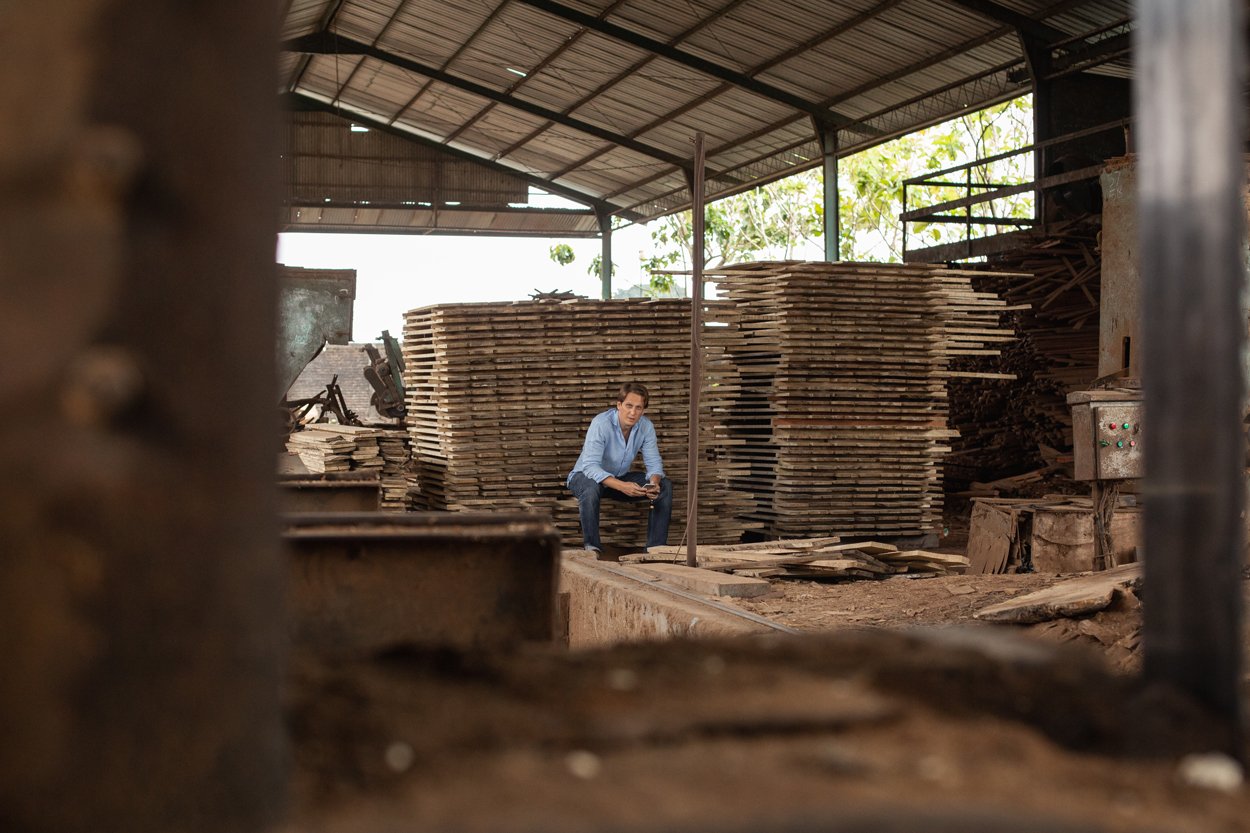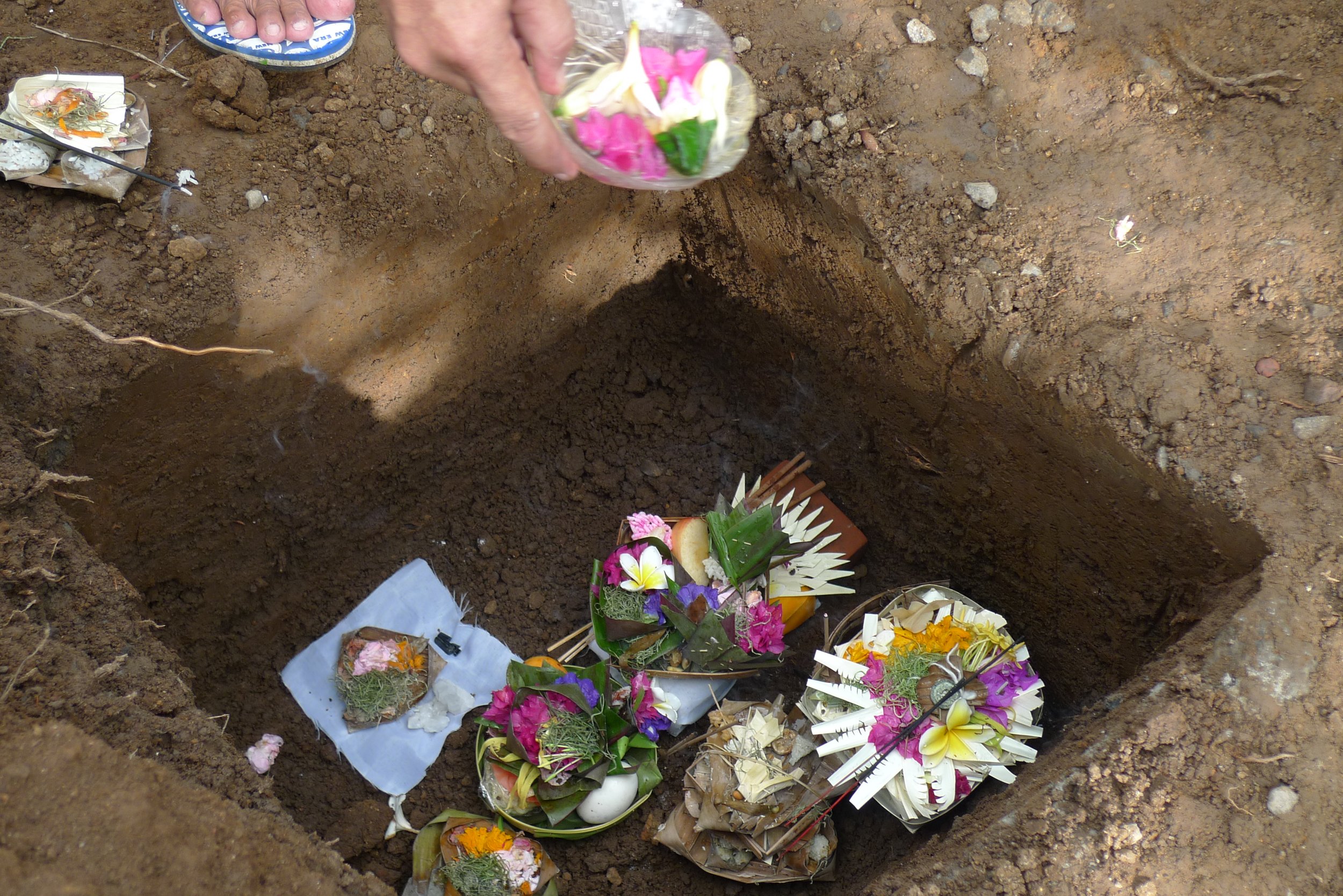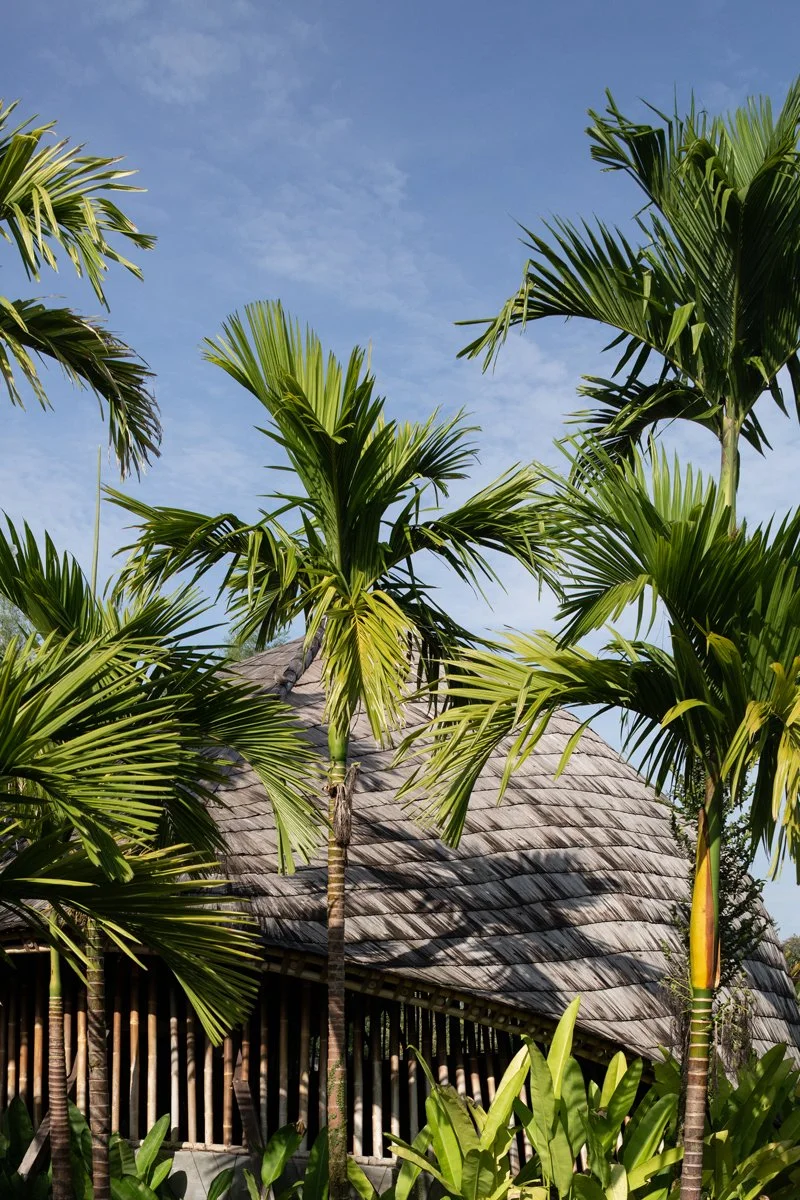
DESIGN & ARCHITECTURE
The architecture and interiors of Rumah Hujan Estate, as well as landscaping, have been created by Studio Jenquel located on the premises. The studio draws on the principles of slow design, utilising adaptive and sustainable approaches. The badminton pavilion was a collaborative project together with Ibuku, renowned for their groundbreaking designs in bamboo.

“In a fast-developing world, design is increasingly becoming a generic, mass-produced and predictable component of the physical structures that surround us. Somewhere along the way, cultural aspects have been lost, stories forgotten and meaningful nuances overlooked”
-
Maximillian Jenquel
Interview with Maximillian Jenquel
at Studio Jenquel
OUR TIME OF INCERTITUDE GAVE US CERTITUDE
—
An interview with Maximillian Jenquel
Words by Ameeta Patel / Photographs
by Tomasso Riva
Born in Venezuela, Maximilian Jencquel received his Masters in Interior Design at the ESAG Penninghen in Paris, France. In 2006, he joined Christian Liaigre’s design studio in Paris, and spent several years working across a multitude of international projects. Maximilian decided to leave Paris following his trip to Indonesia in 2010, where he discovered a heartfelt connection to Ubud. After establishing Studio Jencquel in 2011, Maximilian is now pursuing his passion for vernacular architecture and tropical landscapes, which is inspired by his childhood in Venezuela. Today they are the DNA of his creativity and can be seen in Studio Jencquel's rarefied and prestigious projects around the world, from metropolitan Los Angeles to the Brazilian Amazon. Rumah Hujan was his passion project: the home he built for his family.
A: How did you get to Bali? I’m interested in the first time and then deciding to come here and live, as I imagine those are two different stories.
M: There are more than two different stories, with several answers, all of them true, even if sometimes contradictory to each other. I attribute a lot of what I have done to luck or pure coincidence. The first time Bali caught my eye was when I was studying for my master’s in interior design in Paris. My friend had this book by Angelika Taschen, featuring interior designer Linda Garland. Linda had created some extraordinary houses in Bali and I just fell in love with what I saw, and these houses really felt like the reason I was doing what I was doing. Coincidentally, I had been to one of Linda Garland’s projects many years earlier. When I was 12, I went on a boat trip in the Grenadines and my family and I stopped on the island of Mustique and met someone who said “I’m friends with the gardener of David Bowie and he isn’t here at the moment, do you want to see his house?”. So we ended up sneaking into Bowie’s house and, I didn’t know it then, when I started looking up Linda Garland she was quite well known for designing his house in the 80s on Mustique. This was the time when Jagger and Bowie were coming to Bali a lot and Linda Garland was the place to go; she was a bit like the Walter Spies of this generation. In the 30s you had [the artist] Walter Spies; Charlie Chaplin and anyone who came to Bali would go and see Walter, and in the 70s and 80s you would go to see Linda Garland.
Nature is a different story, answering the same question. I grew up in Venezuela and always had a strong connection to nature. We were young and we would throw things in the back of a car and drive for 12 hours and just stop and cook on a beach and camp out there for a week. It was about pushing ourselves and seeing how wild and how far we were willing to go, and this was something I was very attracted to; I could spend a week sleeping in a hammock in the rain outside and there was an appreciation for the nature around it. I did the same when I moved here, exploring the islands across Indonesia, and pushing my own limits.
When starting my fine art degree in Paris, I was confronted with a place far from this wilderness, faced with projects, deadlines and expectations and it forced me to become organised. This contrast between the wild and rigid, mess and organisation started to make sense to both myself and to my aesthetic and has become a theme. When we look at a mound of snow from a distance it just looks like a pile, but when you look up close it's organised, it's geometric and it's perfect. It's just part of human existence to deal with opposing forces that come together. The most interesting thing about my work is trying to understand how we think and function, and apply that thinking to design and architecture.
A: In that respect - first of all, I wanted to know how you came across this location and then secondly you conceived of it as your family home, is that correct?
M: Yes and no. Stefanie, my wife, and I moved to Bali. It was a time of incertitude, but we were here, Stefanie got a job in a hotel and I was just going to the beach, trying to figure it out. I was drawing, designing things, just you know, there was this foolishness about it.
Then I got my first job for this guy who was building a hotel, and he was sourcing wood all over the region. He was taking reclaimed wood, old bridges, factories...using all that timber to build his hotel. In one of those moments, I said ‘next time you go to buy a bridge or something please let me know, I’d love to buy one as well’. So one day he said I’ve found this bridge in Borneo, and this is how much it's going to cost, and we are going to send the money to this guy in the middle of the jungle. And the idea was exciting to me. I had no idea what I was going to do with the bridge, I had no land.
It took almost a year until the wood arrived in Bali, and when it did I didn’t know where to put it. It required a lot of space to store, and nobody wanted to move it, it was ironwood, weighing a tonne. We had looked at a lot of land and almost bought some, but I always pulled out.
because I wasn't sure. And one day our driver, Nyoman, told me about this piece of land in his village. It didn’t have an access road and it was all grown over, but I didn’t have to see the view to imagine how it could open up, I understood this place was something special.
Family yes, the idea was – well, I told my wife we were going to build a family home. I had borrowed money from my father (and clearly had a lot of wood laying around). But when I told my father that I was building a family home, he said, ‘I'm not going to give you money to build a family house, you need to build a business, so you can pay me back’. Still, we began building our family home. Stefanie got pregnant and when our first son was born we moved into the loft [Sebun Kedis] while working on the construction of Rumah Hujan. Once finished, after only 3 months, a woman came knocking saying she wanted to buy it and I said ok. And my wife cried all night long and said ‘you can't sell this house we just finished' and so I called the lady the next day and said I couldn’t sell her the house. So she asked if we would be willing to rent it, which was fine and she rented it while we moved back to the loft. After a year she asked if I could build her a similar house but I told her that my
background was in interior design, that I was not an architect. She said ‘yes but you built this house, right?’ I said I did but maybe lacking methods that an architect might have. Which she thought was fine, she wanted something similar to this and I could do it. So that's how I got my first commission to do architecture. So in the end, ironically, our family home created a business.
A: You’re very aware of nature here. I mean from the instant you arrive, there’s not just the nature that you see, there are layers of sound and smell. I wondered how coming here and it being just a plot, how you harnessed the nature here and how much it played into your design?
M: It goes back to contrasts, I grew up in a family where my parents would take us travelling a lot, having a certain exposure to a level of comfort. But I [also] grew up being able to enjoy raw nature. I would go down into the Amazon with my friends and just go and get lost. In retrospect, I think ‘god how stupid was that’? We could have not come out of there alive. I think what we are seeing here at Rumah Hujan is these two coming together. I wanted to build something that would feel safe and comfortable, but at the same time open to nature. I remember coming out to the construction site and there was a full moon and I was sitting there and just having that connection to the outdoors, it is important. Having the master bedroom in all glass is almost like sleeping in the jungle. You know, I don't do that much anymore in my designs - a lot of bedrooms now I make them open on one side, but closed on the other side. I was somewhere in a transitional space when building the Rumah Hujan rooms, and how I found myself in relation to nature; it was honest.
A: When you came here and started to build, having worked in Paris, [where] you have access to all of these things - I want to hear from you about the reality of building here, how it forced you to think differently and what the experience was like, from the beginning.
M: Well, I mean everything I have done I was lucky to get away with. Having the best of my studies in Paris and having worked for someone like Christian Liaigre on projects - designing Christian’s own apartment, working for people like Larry Gagosian, doing all these projects in different parts of the world, I came here and I was like ‘I know everything’. And little was I to know that I didn't know anything, a lesson that has become a recurring theme in my life.
For Rumah Hujan, the most foolish thing and at the same time the best opportunity in disguise was buying that reclaimed wood from the bridge in Borneo. I had no idea what to do with it, I had this land, but I had never worked with wood, and I had no idea how to build a house. And so, randomly, there was a house being built next door (but for many reasons the build was not moving forward), and there was this foreman, an American guy, Sam, who had lived in Bali for 20 years. He came over and we started speaking he had this very open way of speaking.
and asked ‘what are you doing here?’. So I said, ‘well, I'm building a house’, and he was just looking, probably thinking this poor young fellow doesn't know what the heck he is doing. He didn't have anything else going on, had two children and a family to feed, and a team of really fabulous Balinese carpenters. So I said why don't we build this together and see how it goes?
Though I had been working with craftsmen in France, this was a very different kind of craft. I ended up going with Sam to the sawmill, he became a little bit like a mentor explaining how we cut the wood, this is what we do. I was absorbed and I was learning. When the other woman, that I mentioned before, asked me to build her a house, I wanted to get Sam involved. Sadly he had health issues with one of his children and had to leave the country abruptly. When leaving he said, ‘can you keep on giving these guys work’, and over the years, we [the carpenters] have become like family. We don't have a wood workshop so there's always someone in our house, in the garage with a saw, cutting a piece of furniture, always making something (as we are speaking there are two carpenters who are doing a small table downstairs for Rumah Hujan). Now that the company is growing we are going to
build a proper wood workshop. I've learned a lot in the process and it's been a rich experience. Rumah Hujan and Studio Jencquel, the brand that exists and that is known for all these beautiful things, wouldn't have been possible without the pure opportunity of meeting this American with his team of wood masters. What are the chances that I had all this wood and there was a carpenter sitting next door, smoking cigarettes, looking over at me, ready to work....
A: In that respect I know we have talked about location and setting but going back to what you originally did, what was the process of designing the interiors?
M: I was so focused on building the house that in the beginning a lot of the furniture we improvised with leftover wood. It was like “oh hey we need a bench’ and I’d just do a sketch and work with the carpenters. It wasn't at all an elaborate sketch, it was all in my head. And for me, the backdrop when you’re here, you don’t need much, the view is your piece of art on the wall, the view is everything. That connection to the outdoors - what else do you need? The interior aesthetic - I couldn't have planned it, it was organic. I mean if you look at it from an interior design perspective it's minimal. I designed the gardens, and I think again my love for nature is expressed when the interior becomes the garden.
A: I would be remiss not to ask about your pavilion
M: The badminton pavilion is a collaboration. In Bali everyone plays badminton, they play it in school, it’s a national sport here. The challenge was that it needed to be roofed, because of wind and rain, at a minimum height of 9m. I felt that was high, it was going to be this huge box, how could we make the whole thing blend in more? It occurred to me that by analysing how the shuttlecock flies, the trajectory of the most range it can have, if somebody were to play all day for hours straight and hit every corner that they need to hit, that’s the shape - and the result would be this turtle shell. Elora Hardy from Ibuku was doing these incredible domes in bamboo, so based on my original sketch they designed the structure. Today we also use the court to host tournaments, badminton classes and groups for local children, it brings a nice sense of community.
A: I guess the last question about the property is - what do you want people to feel when they are here (if anything)?
M: Assuming this was all intentional, the emotions that it triggers were not intentional. No matter intentions, Rumah Hujan doesn't leave people impartial and that's interesting because the house is very neutral. It's very simple, it's not a complex home, but somehow its strength is its simplicity. We have built things that are more complicated, more elaborate, more designed, but these properties still don’t steer as much emotion in people as this one does. And I think it has to do with the fact that it's the house itself, but it's also that I was here with Stefanie for every stone that was used, every brick that was laid. We poured our hearts into this. When I see when somebody else does that it doesn't leave me impartial, rather it's humbling, especially for someone starting out not knowing where it will take them. This house has been bought twice and I have been asked to stay here as its guardian - it's an extension of myself and my family somehow. In the end, our time of incertitude gave us certitude.
HOMEWARE
We source local and conscious products in the spirit of our sustainable ambition. The fragrance in our rooms is unique to Rumah Hujan. Ilin Beraroma (Night Rain) is developed together with Republic of Soap, a Balinese company that manufactures small handmade batches. Fresh notes of night blooming jasmine reflect the same flower grown around the property and combines well with magnolia and santal. Morning coffee is sipped from cups created by Gaya. Located in central Ubud, producing handmade ceramics in a range of techniques, with skills passed down through local craftsmen. Utama Spice’s 100% natural aromatherapy products harness Bali’s traditional herbal knowledge, and the young, mostly female, team produces their small batch products in Ubud. We rely on their Begone Bug mosquito spray, which you’ll find located around the house.Sensatia Botanicals grew out of a small Indonesian fishing village to become an internationally acclaimed brand. Their high-quality cruelty-free raw materials and ingredients, from fresh mint to invigorating herbs, are put to best use enhancing your outdoor shower experience. Our food and flowers are local grown and harvested.













































